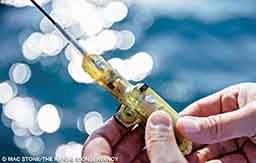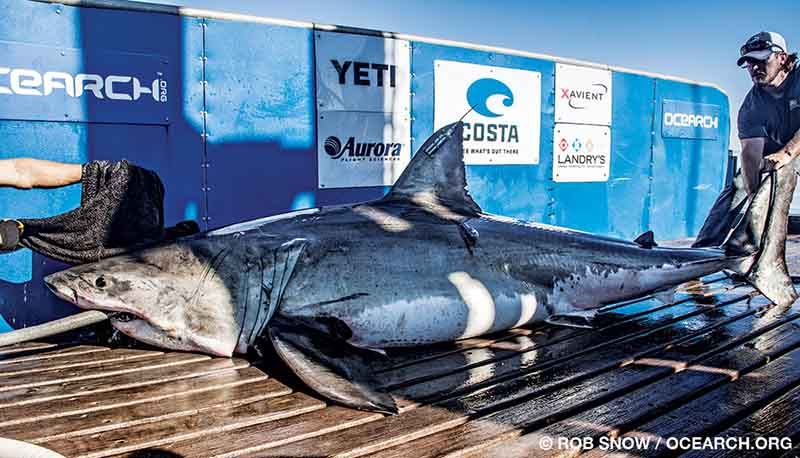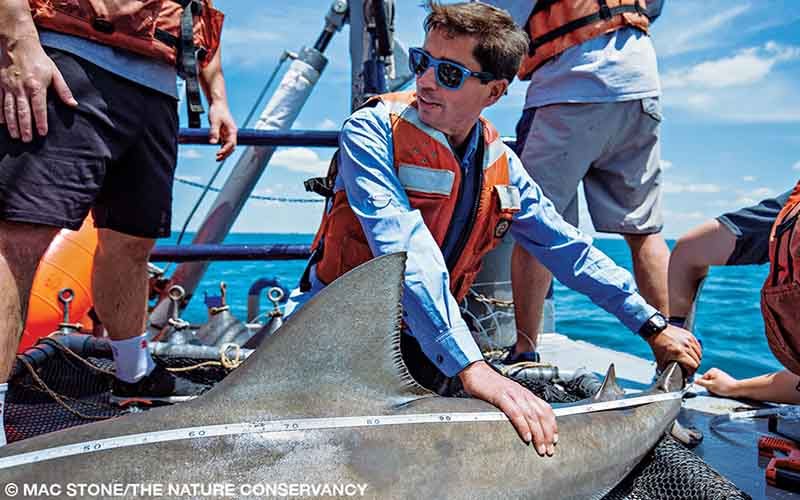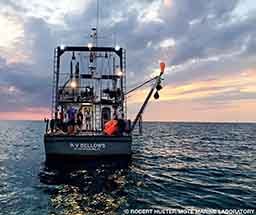For many divers, spotting a shark can be the highlight of a dive. If the shark bears a tracking tag, the sighting might represent a success for science, too.

Scientists use tags to study the abundance and movements of sharks, which helps determine where they most need protection. Worldwide, 26 species of sharks appear as endangered or critically endangered on the Red List of Threatened Species compiled by the International Union for Conservation of Nature (IUCN), and about a quarter of all shark species are considered vulnerable or threatened.
Researchers from Mote Marine Laboratory, The Nature Conservancy, New College of Florida and Eckerd College tagged 34 blacktip, blacknose, bull and tiger sharks off the Florida coast in April 2017. They caught sharks on drum lines in shallow water near shore and longlines set in deeper water and then brought the animals on board to apply a numbered dart tag. In use for nearly 100 years, these inexpensive and easy-to-apply tools provide essentially two data points: location at application and location at recovery.
“That information tells us a little about range and migration, but it doesn’t paint a complete picture,” explained Robert Hueter, director of Mote’s Center for Shark Research. “You could tag a lot of animals in an area and recapture some of them a year later but not know whether in that year they traveled around the planet or stayed in the same spot.”
Still, the tags provide useful data, including the first evidence that some shark species make annual trips around the entire North Atlantic, Hueter said.
More technologically advanced — and more expensive — satellite, or SAT, tags transmit their location to Argos satellites whenever they come above the water’s surface. This allows scientists to more closely track a shark’s ongoing movements. For example, a 2010 paper by University of Miami’s Neil Hammerschlag and colleagues reported on SAT tag data that showed white sharks migrating more than 6,000 miles, whale sharks diving deeper than 3,000 feet and basking sharks hibernating.
Track Some Sharks
Curious what Evelyn, Emma and Fitzy are up to or where they’re at? Identify and track a variety of sharks via Ocearch. Click on the shark’s name to learn more about it.
Scientists have also tracked whale sharks fitted with satellite tags off Mexico’s Yucatan Peninsula. Some of the sharks were found in the middle of the South Atlantic within five months, providing the first evidence these sharks ventured that far.

During the 2017 expedition scientists placed a satellite tag on a juvenile male tiger shark that by early June had traveled nearly 1,000 miles, venturing west of the Florida Keys. A satellite-tagged juvenile female bull shark stayed closer to shore, moseying 150 miles southward to hang around Pine Island Sound then heading back north.
Scientists also use a type of tag called an accelerometer data logger. This device records multiple data points per second, including an animal’s speed, body movements and posture, which indicate its general well-being and behavior. Mote scientists used these data to study how catch-and-release activities affect sharks, identifying 19 specific measures to indicate survival and recovery. Accelerometers cost only about 15 percent of what satellite tags cost and can be reused multiple times. “We hope that eventually we’ll be able to use accelerometers to determine things like when and where sharks feed and mate,” Hueter said. These additional details about where sharks go and when and what they do there will help improve management and conservation of these species. For example, tagging data can help scientists determine a species’ home range as well as how much of that range falls within protected areas or overlaps with commercial fishing areas, Hammershlag said. That makes it possible to configure boundaries of both types of areas to make protections more effective.
Why go to all this trouble to protect sharks? Aside from their allure for divers, these top-of-the-food-chain predators play key roles in healthy oceans.

bull shark.
“Eliminating sharks destabilizes the balance of the ecosystem,” Hueter said. “You can actually have collapse of the system and death of habitats. We have field studies that show that shark depletion from overfishing has resounding, profound effects on habitats such as coral reefs.”
Sharks also have significant economic value. Scientists estimate that shark tourism generates more than $314 million annually worldwide, including some $124 million in the Caribbean, $40 million in Australia and New Zealand, $80 million in the Bahamas and $20 million in the Maldives. Shark diving tourism in particular has grown significantly in the past 10 to 15 years.
“People have become more educated about the low risk in diving with sharks when things are done right,” Hueter said. This kind of sustainable use helps protect sharks, he added, by making them valuable to local economies. “Then it makes no sense to just burn through the resource for short-term economic benefit.”
Sharks even have potential biomedical value; they might be naturally resistant to cancer, and their wounds heal more rapidly than those of mammals. Studying these characteristics could lead to treatments for disease and injury in humans.
Many shark species seem to be on the rebound, thanks to 25 years of fisheries management practices and increased protections. White shark populations declined significantly in the 1970s and 1980s but increased following implementation of conservation measures in the 1990s, according to a 2014 study. Fisheries stock assessments by the National Oceanic and Atmospheric Administration documented increases in blacktip sharks as well.

Fishermen who catch a tagged shark should follow the instructions on the tag and release the shark as quickly as possible. Divers can report sightings of tagged sharks.
“We’re always glad to hear a report of a shark with a tag, especially if you include the shark’s identifying characteristics and can get close enough to read the tag number safely and without handling the animal,” Hueter said. Divers can take a photograph of the tag, which may make it readable, or just post the time and location of a sighting on social media, which may help get the information back to the right research lab. Details about the appearance of the tag itself, such as whether it is biofouled (covered with algae or other organisms) or has a broken antenna, also help scientists.
“Sharks have been around through 400 million years of evolution,” Hueter said. “We want to know what explains their success and look at their vulnerabilities to climate change, overfishing, pollution and other changes. We don’t want to be the generation that destroyed our modern-day dinosaurs.
“The past 25 years have been about the science of decline, and it’s been depressing,” he said, “but the future looks more promising. We now may be doing the science of recovery and restoration of a healthy ocean, and that is very uplifting.”
Healthy oceans and more sharks: That sounds uplifting for divers as well.
| © Alert Diver — Q1 2018 |
|---|
| © Alert Diver — Q1 2018 |